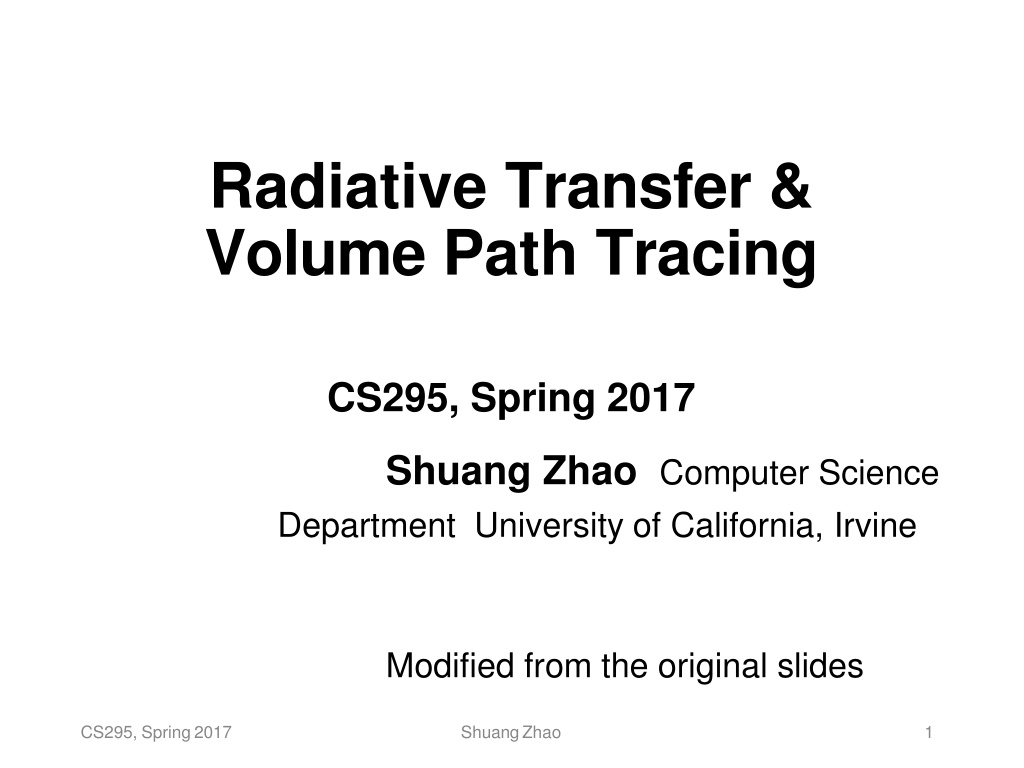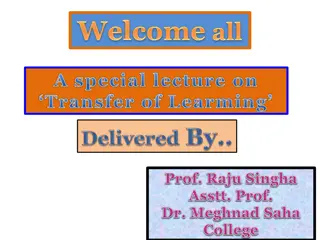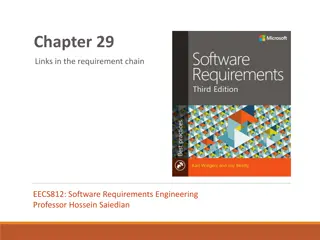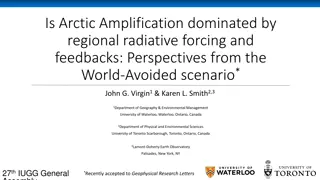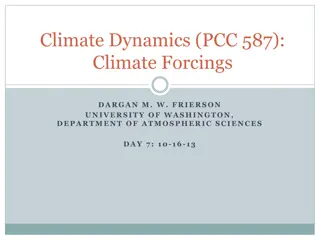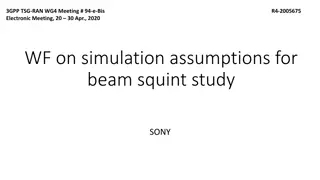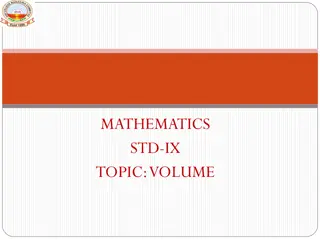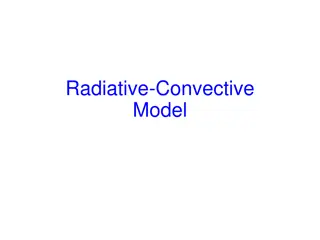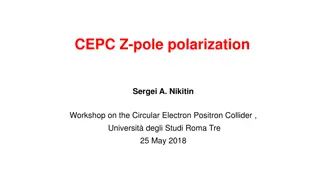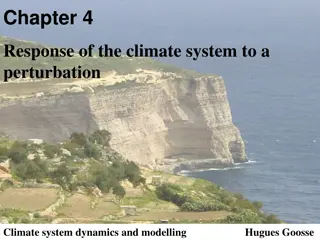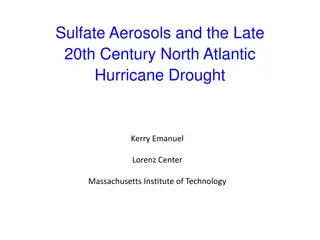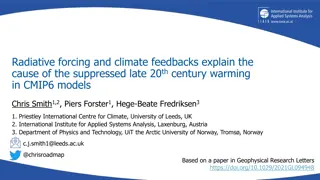Understanding Radiative Transfer and Volume Path Tracing
Explore the mathematical model of radiative transfer for simulating light scattering in participating media and translucent materials through volume path tracing. Learn about subsurface scattering and how radiance changes along ray segments in participating media. Delve into the origins and applications of radiative transfer in various fields, including astrophysics.
Download Presentation

Please find below an Image/Link to download the presentation.
The content on the website is provided AS IS for your information and personal use only. It may not be sold, licensed, or shared on other websites without obtaining consent from the author. Download presentation by click this link. If you encounter any issues during the download, it is possible that the publisher has removed the file from their server.
E N D
Presentation Transcript
Radiative Transfer & Volume Path Tracing CS295, Spring 2017 Shuang Zhao Computer Science Department University of California, Irvine Modified from the original slides CS295, Spring2017 ShuangZhao 1
Todays Lecture Radiative transfer The mathematical model to simulate light scattering in participating media (e.g., smoke) and translucent materials (e.g., marble and skin) Volume path tracing (VPT) A Monte Carlo solution to the radiative transfer problem Similar to the normal PT from previous lectures CS295, Spring2017 ShuangZhao 2
Radiative Transfer CS295: Realistic Image Synthesis CS295, Spring2017 ShuangZhao 3
Participating Media [Kutz et al. 2017] CS295, Spring2017 ShuangZhao 4
Translucent Materials [Gkioulekas et al. 2013] CS295, Spring2017 ShuangZhao 5
Subsurface Scattering Light enters a material and scatters around before eventually leaving or absorbed X Absorbed Participating medium CS295, Spring2017 ShuangZhao 6
Subsurface Scattering Light enters a material and scatters around before eventually leaving or absorbed Scattered Participating medium CS295, Spring2017 ShuangZhao 7
Subsurface Scattering Light enters a material and scatters around before eventually leaving or absorbed Participating medium CS295, Spring2017 ShuangZhao 8
Can we use the rendering equation? Radiance is not constant for each ray segment! We need to consider how the radiance change during the ray segment Participating medium CS295, Spring2017 ShuangZhao 9
Radiative Transfer A mathematical model describing how light interacts with participating media Originated in physics Now used in many areas Astrophysics (light transport in space) Biomedicine (light transport in human tissue) Graphics Nuclear science & engineering (neutrontransport) Remote sensing CS295, Spring2017 ShuangZhao 10
Radiative Transfer Equation (RTE) Focus on how radiance changes at each point and direction Consider , not
Radiative Transfer Equation (RTE) Differential radiance In-scattering Out-scattering & absorption Emission Out-scattering Emission & absorption In-scattering CS295, Spring2017 ShuangZhao 12
Radiative Transfer Equation (RTE) Out-scattering Emission & absorption In-scattering The RTE is a first-order integro-differential equation For a participating medium in a volume boundary , the RTE governs the radiance values inside this volume (i.e., for all with ) The boundary condition is the radiance field on the boundary (i.e., L(x, ) for all ) CS295, Spring2017 ShuangZhao 13
Radiative Transfer Equation (RTE) Out-scattering Emission & absorption In-scattering Differential radiance Scattering coefficient: Phase function: given x and i Extinction coefficient: Source term: , , a probability density over CS295, Spring2017 ShuangZhao 14
Radiative Transfer Equation (RTE) Out-scattering Emission & absorption In-scattering t controls how frequently light scatters and is also known as the optical density The ratio between s and t controls the fraction of radiant energy not being absorbed at each scattering and is also known as the single-scattering albedo CS295, Spring2017 ShuangZhao 15
Radiative Transfer Equation (RTE) Out-scattering Emission & absorption In-scattering The phase function fp is usually parameterized as a function on the angle between i and .Namely, Example: the Henyey-Greenstein (HG) phase function with parameter -1 < g < 1 (more forward scattering): CS295, Spring2017 ShuangZhao 16
The Integral Form of the RTE Integro-differential equation Integral equation It is desirable to rewrite the RTE as an integral equation which can then be solved numerically using Monte Carlo methods CS295, Spring2017 ShuangZhao 17
Integral Form of the RTE For any distance for the ray (x, - ) to hit the boundary other words, , let h(x, ) denotes the minimal . In When (x, - ) never hits the boundary, This can happen when the volume is infinite For any , let with CS295, Spring2017 ShuangZhao 18
Integral Form of the RTE For any , the attenuation between x and y is A line integral between x andy For homogeneous media with for all x andy , CS295, Spring2017 ShuangZhao 19
Integral Form of the RTE Attenuation In-scattering Emission where Attenuation Boundary cond. (The second term vanishes when ) CS295, Spring2017 ShuangZhao 20
Kernel Form of the RTE Kernel function Source function (known term) where CS295, Spring2017 ShuangZhao 21
Operator Form of the RTE Phase space: For any real-valued function g on , define operator K as where Then, the RTE becomes Similar to the RE! Yield Neumann series CS295, Spring2017 ShuangZhao 22
Start from here Volume Path Tracing CS295: Realistic Image Synthesis CS295, Spring2017 ShuangZhao 23
Solving the RTE Given the similarity between the RTE and the RE, Monte Carlo solutions to the RE can be adapted to solve the RTE Volume path tracing Volume adjoint particle tracing Volume bidirectional path tracing CS295, Spring2017 ShuangZhao 24
Volume Path Tracing where Known Basic idea Draw Draw i fromp( i) Evaluate L(r, i) recursively from CS295, Spring2017 ShuangZhao 25
Free Distance Sampling is called the free distance and is sampled from where with 0 being an arbitrary positive number p gives an exponential distribution with varying parameters CS295, Spring2017 ShuangZhao 26
Free Distance Sampling For all , it holds that CS295, Spring2017 ShuangZhao 27
Free Distance Sampling where CS295, Spring2017 ShuangZhao 28
Free Distance Sampling By applying Monte Carlo integration, we have Pseudocode: Draw from p If , return Otherwise,return CS295, Spring2017 ShuangZhao 29
Direction Sampling One extra integral remains: i can be sampled basedon In practice, probability density on i, yielding is usually a valid CS295, Spring2017 ShuangZhao 30
Volume Path Tracing radiance(x, ): compute h = h(x, ) # using ray tracing How to implement this? draw if < h: r = x * draw i return s(r)/ t(r)*radiance(r, i) + Q(r, )/ t(r) else: return boundaryRadiance(x h* , ) CS295, Spring2017 ShuangZhao 31
Free Distance Sampling Methods How to draw samples from this distribution? Homogeneous media Let , then and can be drawn using the inversion In this case, method: CS295, Spring2017 ShuangZhao 32
Free Distance Sampling Methods Heterogeneous media varies with x, causing p does not have a close-form expression in general to vary with Common sampling methods Ray marching Delta tracking CS295, Spring2017 ShuangZhao 33
Ray Marching One can apply the inversion method by 1. Drawing from U(0, 1) 2. Finding satisfying This is usually achieved numerically by iteratively increasing with some fixed step size reaches The step size is generally picked according to the underlying representation of t(x) (e.g., voxelsize) until CS295, Spring2017 ShuangZhao 34
Ray Marching Pros For each sample , can be obtained easily Cons Biased (for any finite step size Resolution dependent needs to be picked based on the resolution ofthe density ( t)field Slow for high-resolution densityfields ) CS295, Spring2017 ShuangZhao 35
Delta Tracking Also known as Woodcock tracking Basic idea Consider the medium to have homogeneousdensity , and use it to draw freedistances To compensate the fact that phantom densities have been introduced, the sampling process continues with probability at each ri CS295, Spring2017 ShuangZhao 36
Delta Tracking Pseudocode: deltaTracking(x, , t ) max compute h using ray tracing = 0 while < h: += -log(rand())/ tmax r = x - * if rand() < t(r)/ t : max break return CS295, Spring2017 ShuangZhao 37
Delta Tracking Pros Unbiased Resolution independent Cons For each sample available Slow for density fields with widely varying tvalues (i.e., tmax >> t(x) for manyx) , is not immediately CS295, Spring2017 ShuangZhao 38
Volume Path Tracing (VPT) radiance(x, ): compute h = h(x, ) This basic version can be improved using techniques we have seen earlier: Russian roulette Next-event estimation Multiple importance sampling draw if < h: r = x * draw i return s(r)/ t(r)*radiance(r, i) + Q(r, )/ t(r) else: return boundaryRadiance(x h* , ) CS295, Spring2017 ShuangZhao 39
VPT with Next-Event Estimation The RTE Namely, implies that . where By drawing distribution, we have from the aforementioned exponential CS295, Spring2017 ShuangZhao 40
VPT with Next-Event Estimation The remaining integral is then split into two: Estimate directly by area sampling or MIS direct illumination Estimate recursively by drawing ibased on fp indirect illumination CS295, Spring2017 ShuangZhao 41
VPT with Next-Event Estimation Pseudocode: scatteredRadiance(x, ): compute h = h(x, ) # using ray tracing draw if < h: r = x * rad = directIllumination(r, ) draw i rad += scatteredRadiance(r, i) return s(r)/ t(r)*rad else: return 0 CS295, Spring2017 ShuangZhao 42
Direct Illumination for VPT Recall that For non-emissive materials, Q vanishes and In this case, Boundary radiance Change of measure The area integral can be further restricted to the subsetof where the boundary radiance is non-zero CS295, Spring2017 ShuangZhao 43
Direct Illumination for VPT Phase function sampling: Draw i based onfp Area sampling: Draw y from The two strategies can be combined using MIS CS295, Spring2017 ShuangZhao 44
